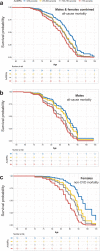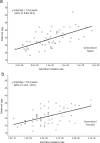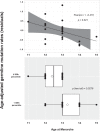Germline mutation rates in young adults predict longevity and reproductive lifespan
- PMID: 32561805
- PMCID: PMC7305191
- DOI: 10.1038/s41598-020-66867-0
Germline mutation rates in young adults predict longevity and reproductive lifespan
Abstract
Ageing may be due to mutation accumulation across the lifespan, leading to tissue dysfunction, disease, and death. We tested whether germline autosomal mutation rates in young adults predict their remaining survival, and, for women, their reproductive lifespans. Age-adjusted mutation rates (AAMRs) in 61 women and 61 men from the Utah CEPH (Centre d'Etude du Polymorphisme Humain) families were determined. Age at death, cause of death, all-site cancer incidence, and reproductive histories were provided by the Utah Population Database, Utah Cancer Registry, and Utah Genetic Reference Project. Higher AAMRs were significantly associated with higher all-cause mortality in both sexes combined. Subjects in the top quartile of AAMRs experienced more than twice the mortality of bottom quartile subjects (hazard ratio [HR], 2.07; 95% confidence interval [CI], 1.21-3.56; p = 0.008; median survival difference = 4.7 years). Fertility analyses were restricted to women whose age at last birth (ALB) was ≥ 30 years, the age when fertility begins to decline. Women with higher AAMRs had significantly fewer live births and a younger ALB. Adult germline mutation accumulation rates are established in adolescence, and later menarche in women is associated with delayed mutation accumulation. We conclude that germline mutation rates in healthy young adults may provide a measure of both reproductive and systemic ageing. Puberty may induce the establishment of adult mutation accumulation rates, just when DNA repair systems begin their lifelong decline.
Conflict of interest statement
The authors declare no competing interests.
Figures




Similar articles
-
Is there a trade-off between fertility and longevity? A comparative study of women from three large historical databases accounting for mortality selection.Am J Hum Biol. 2009 Jul-Aug;21(4):533-40. doi: 10.1002/ajhb.20893. Am J Hum Biol. 2009. PMID: 19298004 Free PMC article.
-
Familial aggregation of survival and late female reproduction.J Gerontol A Biol Sci Med Sci. 2009 Jul;64(7):740-4. doi: 10.1093/gerona/glp055. Epub 2009 May 4. J Gerontol A Biol Sci Med Sci. 2009. PMID: 19414513 Free PMC article.
-
Assisted reproductive technology use and outcomes among women with a history of cancer.Hum Reprod. 2016 Jan;31(1):183-9. doi: 10.1093/humrep/dev288. Epub 2015 Nov 17. Hum Reprod. 2016. PMID: 26577302 Free PMC article.
-
The effect of physical activity on reproductive health outcomes in young women: a systematic review and meta-analysis.Hum Reprod Update. 2019 Sep 11;25(5):541-563. doi: 10.1093/humupd/dmz013. Hum Reprod Update. 2019. PMID: 31304974
-
Delayed child-bearing.J Obstet Gynaecol Can. 2012 Jan;34(1):80-93. doi: 10.1016/S1701-2163(16)35138-6. J Obstet Gynaecol Can. 2012. PMID: 22260768 Review.
Cited by
-
The Evolutionary Interplay of Somatic and Germline Mutation Rates.Annu Rev Biomed Data Sci. 2024 Aug;7(1):83-105. doi: 10.1146/annurev-biodatasci-102523-104225. Epub 2024 Jul 24. Annu Rev Biomed Data Sci. 2024. PMID: 38669515 Free PMC article. Review.
-
Fundamental equations linking methylation dynamics to maximum lifespan in mammals.Nat Commun. 2024 Sep 16;15(1):8093. doi: 10.1038/s41467-024-51855-z. Nat Commun. 2024. PMID: 39285199 Free PMC article.
-
From DNA damage to mutations: All roads lead to aging.Ageing Res Rev. 2021 Jul;68:101316. doi: 10.1016/j.arr.2021.101316. Epub 2021 Mar 9. Ageing Res Rev. 2021. PMID: 33711511 Free PMC article. Review.
-
Elucidating the Transcriptional States of Spermatogenesis-Joint Analysis of Germline and Supporting Cell, Mice and Human, Normal and Perturbed, Bulk and Single-Cell RNA-Seq.Biomolecules. 2024 Jul 12;14(7):840. doi: 10.3390/biom14070840. Biomolecules. 2024. PMID: 39062554 Free PMC article. Review.
-
Population size interacts with reproductive longevity to shape the germline mutation rate.Proc Natl Acad Sci U S A. 2025 May 27;122(21):e2423311122. doi: 10.1073/pnas.2423311122. Epub 2025 May 20. Proc Natl Acad Sci U S A. 2025. PMID: 40392851 Free PMC article.
References
-
- Holmes GE, Bernstein C, Bernstein H. Oxidative and other DNA damages as the basis of aging: a review. Mutat. Res. 1992;275:305–315. - PubMed
-
- Navarro CL, Cau P, Lévy N. Molecular bases of progeroid syndromes. Hum. Mol. Genet. 2006;15:R151–161. - PubMed
-
- Martin GM, et al. Somatic mutations are frequent and increase with age in human kidney epithelial cells. Hum. Mol. Genet. 1996;5:215–221. - PubMed
Publication types
MeSH terms
Grants and funding
LinkOut - more resources
Full Text Sources
Miscellaneous

